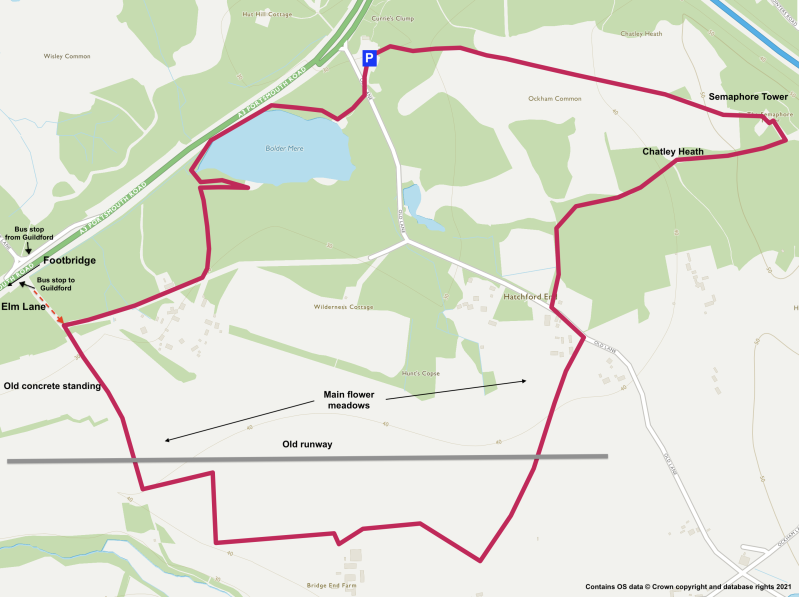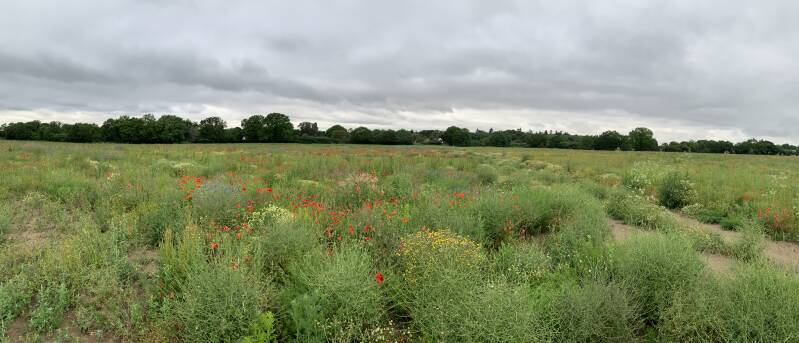Wisley Airfield, Chatley Heath and Boldermere
This walk may have a short shelf life for several reasons but, at least in June 2021, and in spring/summer 2022, this is a ‘must do’! Soon work ‘may’ commence on major road works nearby ahead of the airfield becoming a 2000 house building site.
Update! In August 2022 many of the wildflower patches had been replaced by sweetcorn crops. The walk is still a lovely one, birds like linnets and green woodpeckers were everywhere and signs of badgers and foxes.
Park at what is known as Ockham Bites, a car park off the A3 opposite Wisley RHS, nearest postcode KT11 1NA. There is an outdoor/takeaway café here with picnic benches. Buses (No 715) from Guildford stop on the A3 adjacent to RHS Wisley so use the footbridge to cross the busy road. The place you join the walk is shown on the map – walking instructions start with bold italics below.
From the car park, walk down to the car exit lane, turn left into Old Lane and quickly turn right on a tarmac path into the woodland. Follow this path until you see Boldermere through a gap in the reeds. In summer reed warblers are singing here. On the water you should be able to see many birds including common terns, tufted duck, grey heron, Canada goose, coot, moorhen, mallard and occasionally, in summer, maybe a hobby hunting dragonflies. In winter the warblers have gone but more duck appear including the impressive, uncommon goosander. Turn right as best you can and follow the rough path around Boldermere. Reeds and trees will obscure the view but you may get some glimpses of the birdlife on the lake. The path takes you close to the traffic, separated by a sturdy barrier but for a while it’s very noisy and not very pleasant. Follow the path away from the traffic past the end of the lake and when you can (after some boggy bits) turn left to try and follow the southern edge of the water. You will find one or two places with fairly clear views of the water and birds. The rafts usually hold common tern nests, the terns are often seen perching on posts in the water.
Retrace your steps along the southern edge to the path at the end of the lake and turn left following it through the woodland, full of coal tits and goldcrests, until you reach the lane and turn right. There is now a little bit of road walking, it’s quiet but take care. Follow the road for about 300 metres/yards until it turns sharply right – look for a bridlepath to the left.
(Join the route here if you came by bus, follow the dotted line down Elm Lane and cross into the old concrete standing area).
Take the bridlepath onto a large area of old concrete standing, part of the old Wisley airfield complex. This is gradually becoming overgrown with nature reclaiming its place. Teasels, thistles, evening primrose and stonecrop can all be seen as you follow the footpath in a straight line (marked by fairly clear yellow lines on the concrete) and through the hedgerow on the other side. For a while now skylarks will be your constant companions. Going up the hill you pass crops but also, on the left, some areas of wildflowers in summer that are really beautiful.
You cross the old tarmac runway and turn left along the edge of the vegetation, turning right again to keep to the edge. Watch for the rabbits on the ground around you for a while. You meet a hedgerow where you turn left along the edge of the field. Paths here can be a bit overgrown in summer. The hedgerow has many blackcaps, garden warblers, wrens and dunnocks. Over the hedge is a field often with cattle and calves grazing. Swallows hawk for insects over the grassland. You reach a path intersection at the end of the field so turn right and walk a few yards towards the farm. They have domestic geese here you may see or hear. Pied wagtails are often flitting around and jackdaws can be noisy in the barns and trees.
The farmyard is like an old car graveyard but after a few yards, look for a path on your left and turn left angling back across the grass to the hedgerow. Follow the path and cross the stile. This path is long grass and flowers. Poppies grow here along with mallow, thistles and much more. Linnets seem to favour this thin hedgerow and more skylarks fly above. Painted lady butterflies were here in spring. Watch the sky for buzzards and red kites. The path angles right, follow it and you will then reach a stile and turn left back over the hill. You pass the beacon in the field over to your right which is used for the guidance of Heathrow traffic.
As you go over the brow of the hill, in June and July, an amazing sight of beautiful wildflowers is in front of you. Poppies, chamomile and cornflowers to name just a few. This is worth exploring for the butterflies and flowers while skylarks still sing overhead. Follow the path down the hill and go over the stile, then down to the lane.
Cross the lane turning left for about 50 metres/yards before turning right onto a track into the woodland. Sycamore and hornbeam trees with their strange twisted bark will be found here and a pond on your right, seemingly good for dragonflies in the summer. As you reach the end of the woodland turn right. This virtually straight stretch, a bridlepath, is about half a kilometre, 750 yards. Follow the path along with the heath on your left which is rather overgrown with birch and you soon enter woodland. You will then cross a wide track and continue slightly angled right, still on the bridlepath. You will eventually reach a track crossing your path just before the big trees and you can hear the M25 close behind them. Turn left here and you will quickly see the Semaphore Tower. This building is part of the Royal Navy Semaphore Line that linked Portsmouth and Whitehall and operated 1822 to 1847. It’s 60ft high with 5 storeys. It has been renovated as a monument now available to rent for holidays by the Landmark Trust. There are free open days in September. See here
Now, having passed the tower on your right continue on what is (but may not immediately look like) a long straight path across the heath. So, after the tower the route will very quickly split, pass the bigger birch trees keeping them to your left and take the narrower path straight on trying to stay in the same direction (west north west WNW for those with a compass!) If you stay on the main track by accident you will just do a slight extra loop and return to the same path but need to angle right where they join. As you cross the heath there are good chances of seeing or hearing Dartford warbler, woodlark, cuckoo, certainly chiffchaff and whitethroat in summer. All the time the big trees will be way over to your right until you finally enter them on a well-used clear path which takes you back to your vehicle. If somehow you get the path wrong you will eventually meet Old Lane so turn right and go back to your car and a well-earned coffee, cake or bacon sandwich!
For the bus travellers just continue at the top of these instructions (third paragraph) to pass Boldermere and back to Elm Lane.
June flower display



